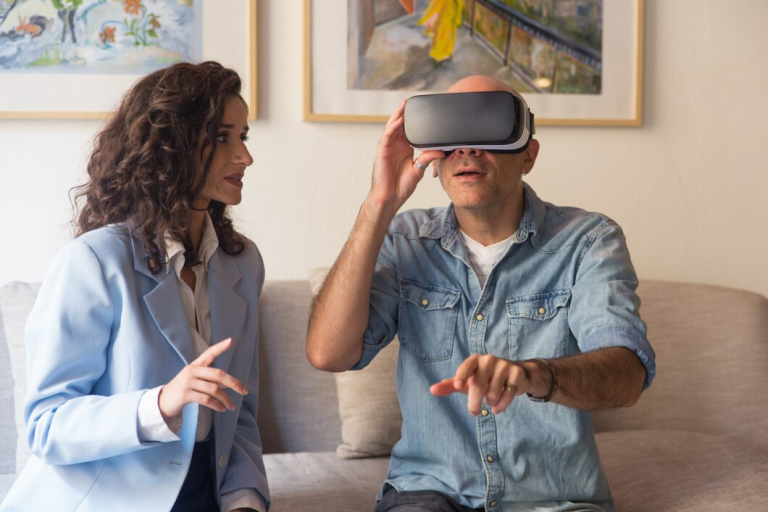Is Virtual Reality a Smart Investment for Architecture Firms?
Virtual Reality (VR) is transforming architecture and design, but many firms hesitate to adopt it due to perceived costs and implementation challenges. However, as technology advances and competition increases, firms using VR are seeing improved efficiency, faster client approvals, and significant cost savings.
Before investing in VR, architecture firms must assess whether the benefits outweigh the costs. This guide provides a comprehensive cost-benefit analysis to help firms decide if VR is a smart financial move.
Understanding the Costs of VR Adoption
The initial investment in VR varies depending on firm size, project complexity, and level of integration. Here’s a breakdown of the primary costs associated with VR adoption.
1. Hardware Costs
Investing in VR headsets and workstations is the first step.
| VR Hardware | Cost Range | Best For |
|---|---|---|
| Meta Quest 3 | $500 – $700 | Entry-level VR for client walkthroughs |
| HTC Vive Pro 2 | $1,000 – $1,400 | Mid-range professional VR visualization |
| Varjo XR-3 | $5,000 – $6,500 | High-end enterprise VR with extreme detail |
2. Software & Licensing Costs
VR software must integrate with existing BIM and CAD tools.
| VR Software | Annual Cost | Features |
|---|---|---|
| Enscape | $500 – $1,000 | Real-time VR visualization for Revit & SketchUp |
| Twinmotion | $499 (one-time) | Easy-to-use photorealistic rendering |
| Unreal Engine | Free – Enterprise Pricing | High-end architectural visualization |
| IrisVR Prospect | $1,200 – $2,400 | Immersive VR for construction & design |
3. Training & Implementation Costs
Learning new technology requires employee training and workflow adjustments.
- VR training sessions: $2,000 – $5,000 per firm
- Time investment for staff learning: 20–40 hours per employee
4. IT Infrastructure & Maintenance
VR demands high-performance workstations and cloud storage.
- VR-ready computer setup: $2,500 – $5,000 per machine
- Cloud storage & rendering services: $50 – $500/month
Total Estimated Upfront Investment:
For a small-to-medium-sized architecture firm, the initial cost of adopting VR ranges from $10,000 to $50,000, depending on the level of integration.
The ROI of VR: How It Pays Off Over Time
While the upfront costs may seem high, VR adoption leads to long-term savings and revenue growth through higher efficiency, fewer revisions, and better client engagement.
1. Faster Project Approvals & Client Satisfaction
Traditional 2D renderings can be difficult for clients to interpret, leading to miscommunication and project delays. VR solves this by allowing clients to experience designs in full scale, leading to:
- 50% faster client approvals (Harvard Business Review)
- 30-40% reduction in design revisions
- Higher client engagement and retention rates
Cost Savings: Fewer revisions save 10-20% in labor costs per project, reducing overhead expenses.
2. Reduced Construction Errors & Cost Overruns
Errors in architectural plans can be expensive once construction begins. VR allows teams to identify design flaws early, avoiding costly mistakes.
- Up to 80% of construction changes stem from miscommunication in early design phases (McKinsey & Co.)
- VR reduces rework costs by 30% by allowing real-time walkthroughs with clients and contractors
Cost Savings: Reducing construction errors can save firms $50,000–$150,000 per large project.
3. Competitive Advantage & Higher Revenue
Firms offering VR-based client presentations and immersive design reviews gain a market advantage over competitors still using traditional visualization methods.
- VR increases project win rates by 25-35%
- Firms can charge a premium for VR-enhanced design services
Revenue Growth: Firms using VR report a 15-25% increase in project profitability.
4. Time Savings in Design & Collaboration
With VR, architects can:
- Eliminate unnecessary meetings by allowing remote clients to review designs in VR
- Speed up the design process through real-time rendering and model modifications
- Enhance team collaboration by sharing immersive designs with contractors and consultants
Time Savings: Firms save 50-100 hours per project, freeing up resources for new clients.
Break-Even Point: When Does VR Pay for Itself?
Let’s assume a mid-sized architecture firm invests $30,000 in VR adoption.
| Cost Savings & Revenue Increase | Annual Savings |
|---|---|
| Faster project approvals & fewer revisions | $15,000 – $25,000 |
| Reduced construction errors & rework costs | $20,000 – $50,000 |
| Competitive advantage & new projects | $30,000 – $100,000+ |
| Time savings in design & collaboration | $10,000 – $20,000 |
Estimated Payback Period: 12–18 months
After one to two years, most firms recover their investment and begin to see significant cost savings and increased profitability.
Is VR a Good Investment for Your Firm?
When to Invest in VR:
- Your firm regularly handles high-budget commercial or residential projects
- Clients often struggle to visualize designs in 2D or static 3D models
- You want to reduce costly construction errors and project delays
- Your competitors are already using VR, putting you at a disadvantage
When VR May Not Be Necessary:
- Your firm specializes in small-scale renovations or budget projects
- You don’t have clients willing to pay for premium VR-based design services
- Your team lacks the resources or expertise to integrate VR effectively
Final Verdict: Is VR Worth It for Architecture Firms?
For most mid-to-large firms, the cost-benefit analysis shows that VR is a worthwhile investment. While the initial setup cost can range from $10,000 to $50,000, the ROI from faster approvals, reduced errors, and increased revenue can far outweigh the expenses.
Benefits Recap:
- Faster project approvals – Reducing design time by up to 50%
- Fewer revisions & errors – Cutting rework costs by 30-40%
- Higher client satisfaction – Leading to more referrals and repeat business
- Competitive advantage – Positioning firms ahead in a tech-driven industry
For firms looking to stay ahead in the evolving architecture landscape, investing in VR isn’t just an option—it’s becoming a necessity.
Interested in adopting VR for your architecture firm? Contact VRchitects today to explore the best solutions for your business!






